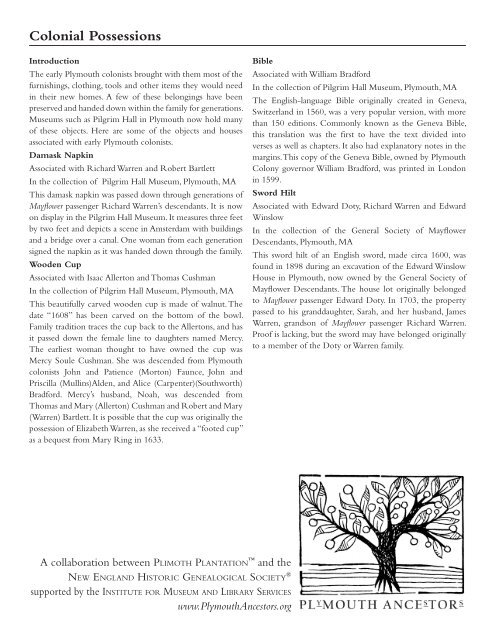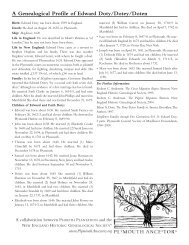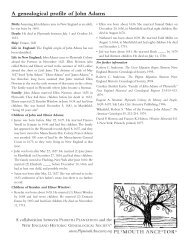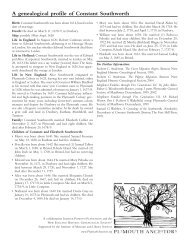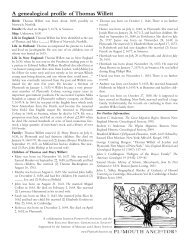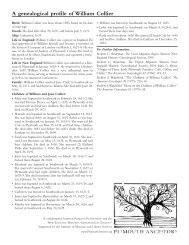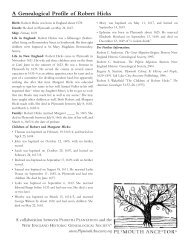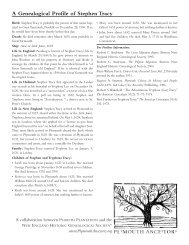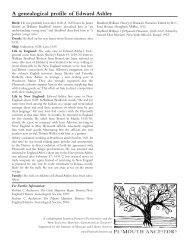Colonial Possessions - Plimoth Plantation
Colonial Possessions - Plimoth Plantation
Colonial Possessions - Plimoth Plantation
You also want an ePaper? Increase the reach of your titles
YUMPU automatically turns print PDFs into web optimized ePapers that Google loves.
<strong>Colonial</strong> <strong>Possessions</strong><br />
Introduction<br />
The early Plymouth colonists brought with them most of the<br />
furnishings, clothing, tools and other items they would need<br />
in their new homes. A few of these belongings have been<br />
preserved and handed down within the family for generations.<br />
Museums such as Pilgrim Hall in Plymouth now hold many<br />
of these objects. Here are some of the objects and houses<br />
associated with early Plymouth colonists.<br />
Damask Napkin<br />
Associated with Richard Warren and Robert Bartlett<br />
In the collection of Pilgrim Hall Museum, Plymouth, MA<br />
This damask napkin was passed down through generations of<br />
Mayflower passenger Richard Warren’s descendants. It is now<br />
on display in the Pilgrim Hall Museum. It measures three feet<br />
by two feet and depicts a scene in Amsterdam with buildings<br />
and a bridge over a canal. One woman from each generation<br />
signed the napkin as it was handed down through the family.<br />
Wooden Cup<br />
Associated with Isaac Allerton and Thomas Cushman<br />
In the collection of Pilgrim Hall Museum, Plymouth, MA<br />
This beautifully carved wooden cup is made of walnut. The<br />
date “1608” has been carved on the bottom of the bowl.<br />
Family tradition traces the cup back to the Allertons, and has<br />
it passed down the female line to daughters named Mercy.<br />
The earliest woman thought to have owned the cup was<br />
Mercy Soule Cushman. She was descended from Plymouth<br />
colonists John and Patience (Morton) Faunce, John and<br />
Priscilla (Mullins)Alden, and Alice (Carpenter)(Southworth)<br />
Bradford. Mercy’s husband, Noah, was descended from<br />
Thomas and Mary (Allerton) Cushman and Robert and Mary<br />
(Warren) Bartlett. It is possible that the cup was originally the<br />
possession of Elizabeth Warren, as she received a “footed cup”<br />
as a bequest from Mary Ring in 1633.<br />
Bible<br />
A collaboration between <strong>Plimoth</strong> <strong>Plantation</strong> and the<br />
new england historic genealogical society ®<br />
supported by the institute for museum and library services<br />
www.PlymouthAncestors.org<br />
Associated with William Bradford<br />
In the collection of Pilgrim Hall Museum, Plymouth, MA<br />
The English-language Bible originally created in Geneva,<br />
Switzerland in 1560, was a very popular version, with more<br />
than 150 editions. Commonly known as the Geneva Bible,<br />
this translation was the first to have the text divided into<br />
verses as well as chapters. It also had explanatory notes in the<br />
margins. This copy of the Geneva Bible, owned by Plymouth<br />
Colony governor William Bradford, was printed in London<br />
in 1599.<br />
Sword Hilt<br />
Associated with Edward Doty, Richard Warren and Edward<br />
Winslow<br />
In the collection of the General Society of Mayflower<br />
Descendants, Plymouth, MA<br />
This sword hilt of an English sword, made circa 1600, was<br />
found in 1898 during an excavation of the Edward Winslow<br />
House in Plymouth, now owned by the General Society of<br />
Mayflower Descendants. The house lot originally belonged<br />
to Mayflower passenger Edward Doty. In 1703, the property<br />
passed to his granddaughter, Sarah, and her husband, James<br />
Warren, grandson of Mayflower passenger Richard Warren.<br />
Proof is lacking, but the sword may have belonged originally<br />
to a member of the Doty or Warren family.
<strong>Colonial</strong> <strong>Possessions</strong><br />
Sword<br />
Associated with John Carver<br />
In the collection of Pilgrim Hall Museum, Plymouth, MA<br />
The ownership of this sword has been attributed to Plymouth<br />
Colony’s first governor, John Carver. It is on loan to the Pilgrim<br />
Society from the Massachusetts Historical Society, The sword<br />
was donated to the Massachusetts Historical Society in 1795 by<br />
Ichabod Shaw of Plymouth. The decoration and workmanship<br />
are typical of English swords of the early 17th century.<br />
Chair<br />
Associated with William Bradford<br />
In the collection of Pilgrim Hall Museum, Plymouth, MA<br />
This chair of black ash was made in Plymouth Colony and<br />
has been dated to 1630-1670. It may have been one of the<br />
two “great wooden chairs” listed in William Bradford’s 1657<br />
inventory. The chair was originally taller, with the bottom<br />
rung standing several inches above the floor. It passed down<br />
through the Bradford and Hedge families, and was donated to<br />
the Pilgrim Hall Museum in 1953.<br />
Hat<br />
Associated with Constance Hopkins Snow<br />
In the collection of Pilgrim Hall Museum, Plymouth, MA<br />
The ownership of this beaver-felt hat has been attributed<br />
to Mayflower passenger Constance Hopkins, who married<br />
Nicholas Snow circa 1626. Hats such as this, with its wide<br />
brim and high crown, were popular with both men and<br />
women in the early 17th century. Beaver furs were sent from<br />
New England to England, where the underfur was processed<br />
into felt for hats.<br />
Razor and Case<br />
Associated with Myles Standish<br />
In the collection of Pilgrim Hall Museum, Plymouth, MA<br />
The razor and case were found at the site of the Myles Standish<br />
house in Duxbury, MA. The razor was probably made in Toledo,<br />
Spain about 1612. It may have come over with Standish aboard<br />
the Mayflower in 1620. The case is made of pasteboard which<br />
was painted and stamped to look like leather.<br />
Cradle<br />
A collaboration between <strong>Plimoth</strong> <strong>Plantation</strong> and the<br />
new england historic genealogical society ®<br />
supported by the institute for museum and library services<br />
www.PlymouthAncestors.org<br />
Associated with the family of William White<br />
In the collection of Pilgrim Hall Museum, Plymouth, MA<br />
This woven wicker cradle is typical of those made in<br />
Holland in the 17th century. According to tradition, William<br />
and Susanna White brought the cradle with them on the<br />
Mayflower in anticipation of the birth of their son, Peregrine.<br />
These cradles were also imported into Plymouth Colony<br />
throughout the 1600s, and may have been purchased later by<br />
another member of the family.<br />
Chest<br />
Associated with William Brewster<br />
In the collection of Pilgrim Hall Museum, Plymouth, MA<br />
This six-board chest was made of Norway pine and iron,<br />
probably in Holland in the early 17th century. It has traces<br />
of dark reddish-brown paint, which is probably original.<br />
According to tradition, William Brewster brought this chest<br />
over from Holland in 1620.<br />
Cradle<br />
Associated with Samuel Fuller<br />
In the collection of Pilgrim Hall Museum, Plymouth, MA<br />
This cradle was made of maple and white pine, probably in<br />
Duxbury, MA between 1680-1720. It has descended in the<br />
family of Samuel Fuller. The maker used solid pine boards and<br />
nailed strips of wood over them in imitation of joined work.<br />
He was most probably a carpenter rather than a joiner.
<strong>Colonial</strong> <strong>Possessions</strong><br />
Fire Back<br />
Associated with Robert Bartlett<br />
In the collection of Pilgrim Hall Museum, Plymouth, MA<br />
This fire back was made of iron, and has been attributed to<br />
the Saugus Ironworks of Massachusetts. The date on its front,<br />
1660, was probably the date of its manufacture. Fire backs were<br />
placed in the rear of a hearth both to protect the bricks and to<br />
reflect heat back into the room. This fire back came from the<br />
house of Joseph Bartlett in Manomet (South Plymouth).<br />
Chest with drawer<br />
Associated with the family of George Morton<br />
In the collection of Pilgrim Hall Museum, Plymouth, MA<br />
This chest with drawer was made of red and white oak,<br />
probably in Plymouth between 1650-1700. It has descended<br />
in the Morton family of Plymouth. The chest has some of<br />
its original painted decoration: a bright red tulip with green<br />
leaves. The design would have stood out dramatically when<br />
the chest was new and the wood pale.<br />
Tankard<br />
Associated with Peter Brown<br />
In the collection of Pilgrim Hall Museum, Plymouth, MA<br />
This tankard was made of oak staves and birch hoops, probably<br />
in England or the Baltics, around 1620. It has descended in the<br />
family of Mayflower passenger Peter Brown. It was probably<br />
made by a cooper, or barrel-maker.<br />
Chair<br />
A collaboration between <strong>Plimoth</strong> <strong>Plantation</strong> and the<br />
new england historic genealogical society ®<br />
supported by the institute for museum and library services<br />
www.PlymouthAncestors.org<br />
Associated with Thomas Prence<br />
In the collection of Pilgrim Hall Museum, Plymouth, MA<br />
This chair of maple and ash was made in Plymouth Colony<br />
in the late 1600s. It has descended in the family of Fortune<br />
passenger Thomas Prence, who served Plymouth Colony as<br />
assistant governor or governor every year between 1634 and<br />
his death in 1673.<br />
Pewter Plate<br />
Associated with William Collier<br />
In the collection of the Museum of Fine Arts, Boston, MA<br />
This large pewter platter, or charger, descended in the family<br />
of William Collier, who arrived in Plymouth Colony by 1633.<br />
It was probably made in 17th-century Scotland, about 1650-<br />
1670. It is currently owned by the Museum of the Fne Arts in<br />
Boston. The charger was a bequest of Mrs. Andrew W. Lawrie,<br />
number 47.1559.
<strong>Colonial</strong> <strong>Possessions</strong><br />
Alden House Historic Site<br />
Associated with John Alden<br />
Property of the Alden Kindred of America, Inc., Duxbury, MA<br />
The Alden property in Duxbury is notable for being in the<br />
same family since its original allotment to John Alden in the<br />
1620s. The property has been owned by the Alden Kindred of<br />
America since 1907. While the original house only survives as<br />
an archaeological site, the oldest section of the Alden House is<br />
believed to date back to 1653.<br />
Isaac Winslow House<br />
Associated with the family of Edward Winslow<br />
Property of the Historic Winslow House Association,<br />
Marshfield, MA<br />
The original house, known as Careswell, was built in 1699 by<br />
Colonel Isaac Winslow, grandson of Edward Winslow. It has<br />
been remodeled and added to over the 300 years years of its<br />
existance, most notably by General John Winslow about 1750.<br />
After passing out of the Winslow family in 1827, the house<br />
was bought in 1919 by three men who formed the Historic<br />
Winslow House Association in 1920. The Association has<br />
owned and operated the house as a museum since that time.<br />
Jabez Howland House<br />
Associated with the family of John Howland<br />
Property of the Pilgrim John Howland Society, Plymouth, MA<br />
The Jabez Howland House is the only existing house in<br />
Plymouth in which Mayflower passengers actually lived. John<br />
and Elizabeth (Tilley) Howland spent winters in the house<br />
with their son Jabez and his family. The oldest part of the<br />
house was built about 1667, but was extensively modified in<br />
the 17th and 18th centuries. The house was privately owned<br />
until 1912 when it was purchased for a museum by the<br />
Pilgrim John Howland Society.<br />
A collaboration between <strong>Plimoth</strong> <strong>Plantation</strong> and the<br />
new england historic genealogical society ®<br />
supported by the institute for museum and library services<br />
www.PlymouthAncestors.org


